

Germanic mythology. Anglo-Saxon paganism. Neorxnawang. Neorxnawang (also Neorxenawang, Neorxnawong; possibly "field of contentment"[1]) is an Old English term used to translate the Christian concept of "paradise" in Anglo-Saxon literature.[2] The term is often theorized as originally having referred to a mythological "heavenly meadow", or place without toil or worries, in Germanic paganism.[3] Etymology[edit] 19th century scholar Jacob Grimm comments that etymological connections have been proposed between Norn and Neorxnawang, but says that the theory raises etymological and lore problems: "The A. gen. pl. neorxana, which only occurs in 'neorxena wong' = paradisus, has been proposed, but the abbreviation would be something unheard of, and even the nom. sing. neorxe or neorxu at variance with norn; besides,the Parcae are nowhere found connected with paradise.
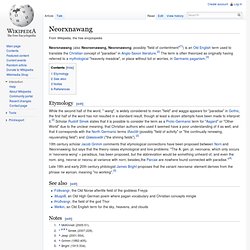
"[4] Late 19th and early 20th century philologist James Bright proposes that the variant neorxena- element derives from the phrase ne wyrcan, meaning "no working".[5] See also[edit] Nine Herbs Charm. The Nine Herbs Charm is an Old English charm recorded in the 10th-century[1] Lacnunga manuscript.[2] The charm is intended for the treatment of poisoning and infection by a preparation of nine herbs.
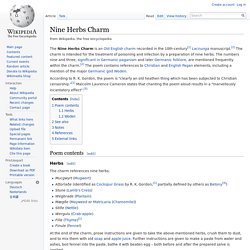
The numbers nine and three, significant in Germanic paganism and later Germanic folklore, are mentioned frequently within the charm.[2] The poem contains references to Christian and English Pagan elements, including a mention of the major Germanic god Woden. According to R. K. Gordon, the poem is "clearly an old heathen thing which has been subjected to Christian censorship.
Other Mythological creatures. Beowulf. Beowulf (/ˈbeɪ.ɵwʊlf/; in Old English [ˈbeːo̯wʊlf] or [ˈbeːəwʊlf]) is the conventional title of an Old English epic poem consisting of 3182 alliterative long lines, set in Scandinavia, commonly cited as one of the most important works of Anglo-Saxon literature due to the fact that it is the oldest surviving epic poem of Old English and also the earliest vernacular English literature.[2] The full poem survives in the manuscript known as the Nowell Codex, located in the British Library.
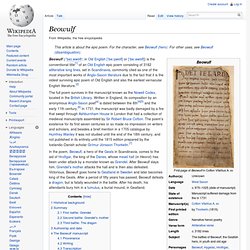
Written in England, its composition by an anonymous Anglo-Saxon poet[a] is dated between the 8th[5] and the early 11th century.[6] In 1731, the manuscript was badly damaged by a fire that swept through Ashburnham House in London that had a collection of medieval manuscripts assembled by Sir Robert Bruce Cotton. Historical background[edit] Approximate central regions of tribes mentioned in Beowulf, with the location of the Angles in Angeln.
Summary[edit] While earlier scholars (such as J.R.R.
Characters in Beowulf. Continental Germanic mythology. Continental Germanic mythology is a subtype of Germanic mythology as practiced in parts of Central Europe during the 6th to 8th centuries, a period of Christianization.
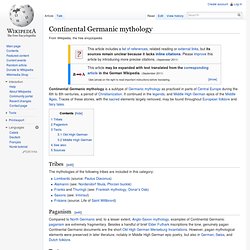
It continued in the legends, and Middle High German epics of the Middle Ages. Traces of these stories, with the sacred elements largely removed, may be found throughout European folklore and fairy tales. Tribes[edit] The mythologies of the following tribes are included in this category: Paganism[edit] Compared to North Germanic and, to a lesser extent, Anglo-Saxon mythology, examples of Continental Germanic paganism are extremely fragmentary.
Texts[edit] Old High German[edit] Middle High German[edit] See also[edit]
Norse mythology. An undead völva, a Scandinavian seeress, tells the spear-wielding god Odin of what has been and what will be in Odin and the Völva by Lorenz Frølich (1895)

Ragnarök. The north portal of the 11th century Urnes stave church has been interpreted as containing depictions of snakes and dragons that represent Ragnarök In Norse mythology, Ragnarök is a series of future events, including a great battle foretold to ultimately result in the death of a number of major figures (including the gods Odin, Thor, Týr, Freyr, Heimdallr, and Loki), the occurrence of various natural disasters, and the subsequent submersion of the world in water.
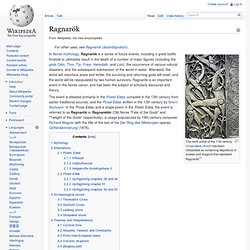
Afterward, the world will resurface anew and fertile, the surviving and returning gods will meet, and the world will be repopulated by two human survivors. Ragnarök is an important event in the Norse canon, and has been the subject of scholarly discourse and theory. The event is attested primarily in the Poetic Edda, compiled in the 13th century from earlier traditional sources, and the Prose Edda, written in the 13th century by Snorri Sturluson. Mythology[edit] The Old Norse word "ragnarok" is a compound of two words. Druid. A druid was a member of the educated, professional class among the Celtic peoples of Gaul, Britain, Ireland, and possibly elsewhere during the Iron Age.
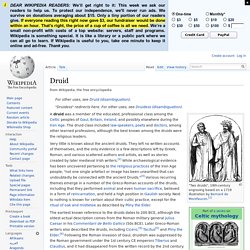
The druid class included law-speakers, poets and doctors, among other learned professions, although the best known among the druids were the religious leaders. Very little is known about the ancient druids. They left no written accounts of themselves, and the only evidence is a few descriptions left by Greek, Roman, and various scattered authors and artists, as well as stories created by later medieval Irish writers.[2] While archaeological evidence has been uncovered pertaining to the religious practices of the Iron Age people, "not one single artefact or image has been unearthed that can undoubtedly be connected with the ancient Druids. The earliest known reference to the druids dates to 200 BCE, although the oldest actual description comes from the Roman military general Julius Caesar in his Commentarii de Bello Gallico (50s BCE).